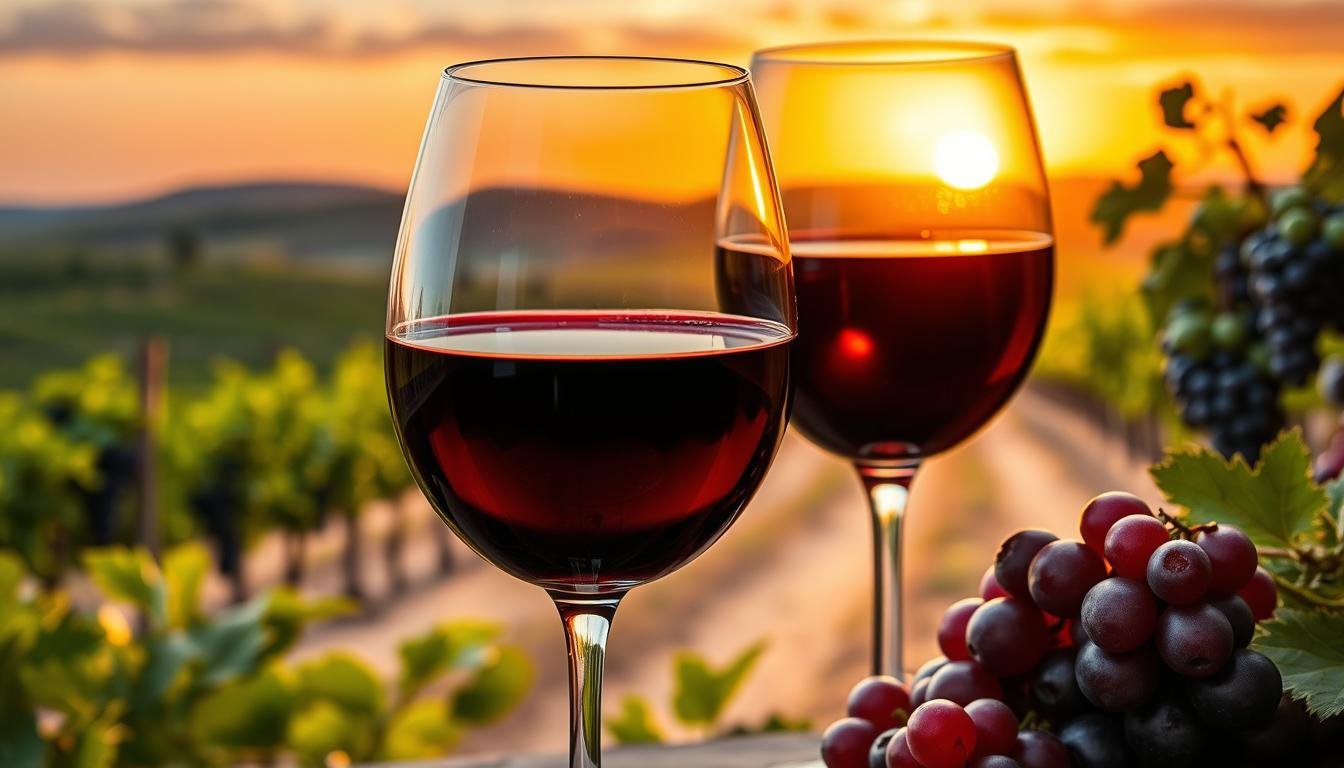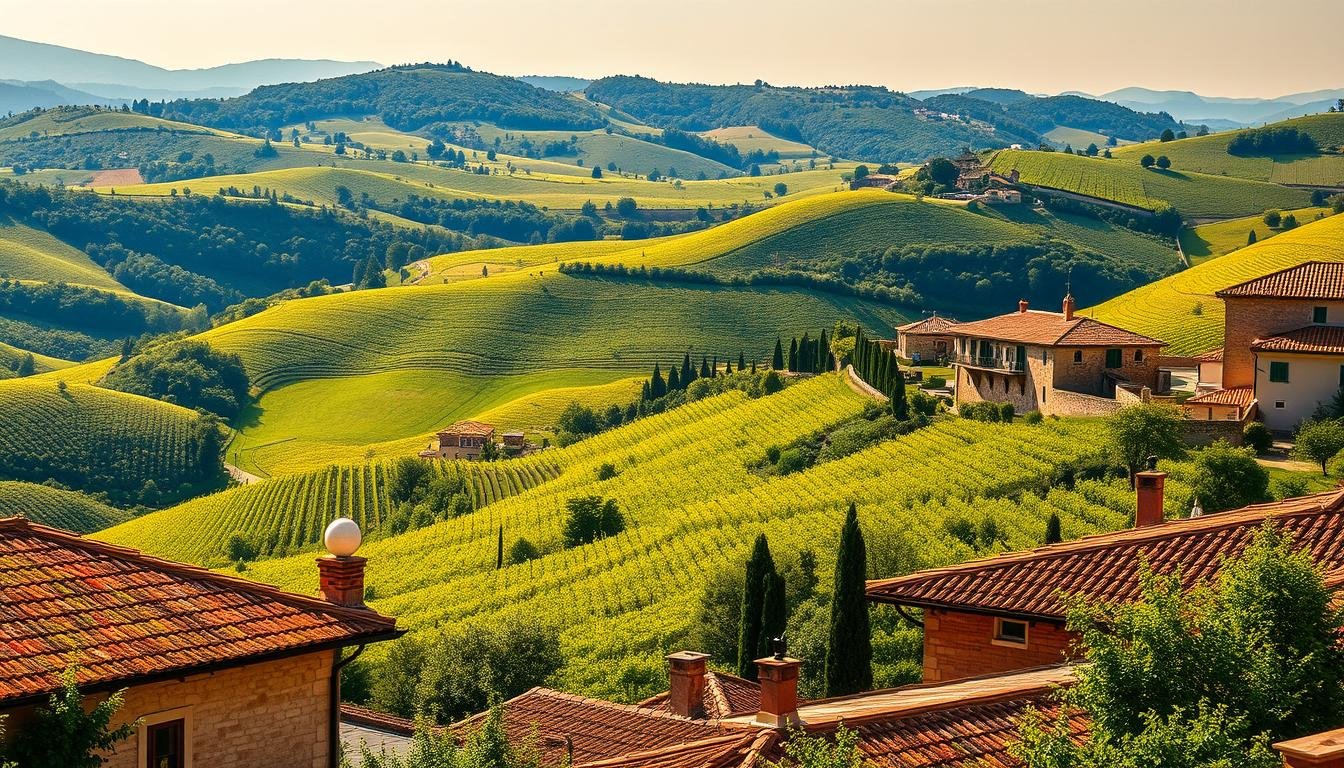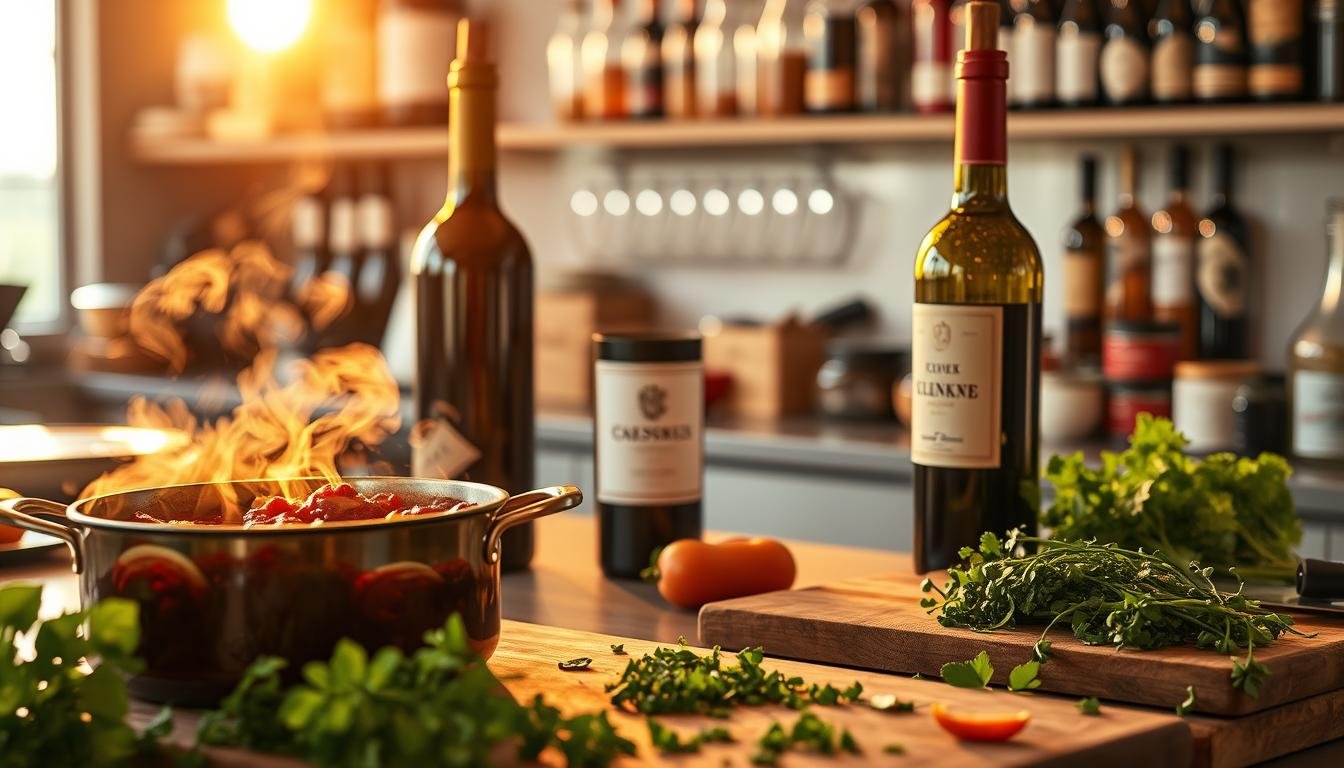Red wine lovers often debate between Merlot and Cabernet Sauvignon. You might wonder what makes them different and how to pick between them. Both grapes are key in Bordeaux blends, mixed with others like Cabernet Franc and Malbec. Knowing the differences between Merlot and Cabernet Sauvignon helps us enjoy their unique flavors.
Merlot is known for being softer and easier to drink. Cabernet Sauvignon, on the other hand, is bold and rich. The choice between Merlot and Cabernet Sauvignon often depends on personal taste. But, knowing their characteristics can guide you in choosing the right wine for any meal.
Key Takeaways
- Merlot and Cabernet Sauvignon are two of the most popular red wine varieties.
- Merlot is generally softer and more approachable, while Cabernet Sauvignon is bolder and more full-bodied.
- The merlot vs cabernet taste debate often comes down to personal preference.
- Understanding the characteristics of each wine can help you make informed decisions when choosing a wine.
- Merlot vs cabernet sauvignon wines have different pairing options, with Merlot pairing well with lighter dishes and Cabernet Sauvignon pairing well with richer dishes.
- Both Merlot and Cabernet Sauvignon are used in Bordeaux blends, which combine these grapes with others like Cabernet Franc, Petit Verdot, and Malbec.
- Exploring the differences between merlot vs cabernet can enhance your wine-drinking experience and help you appreciate the unique characteristics of each variety.
Understanding Wine Basics: Merlot and Cabernet Sauvignon
Exploring Merlot and Cabernet Sauvignon starts with knowing their origins. Merlot comes from Bordeaux, France. Cabernet Sauvignon, on the other hand, is a mix of Cabernet Franc and Sauvignon Blanc. This mix gives each wine its unique taste and health benefits.
Merlot and Cabernet Sauvignon have distinct traits. Merlot is known for its smooth taste and plum flavors. Cabernet Sauvignon, however, is bold with flavors of currants and blackberries.
Both wines are dry and often aged in oak barrels. This aging process adds vanilla and cedar notes. Knowing these basics helps you choose the right wine for your taste.
| Wine Variety | Origin | Flavor Profile |
|---|---|---|
| Merlot | Bordeaux, France | Smooth, approachable, with plum and blueberry notes |
| Cabernet Sauvignon | Accidental crossing of Cabernet Franc and Sauvignon Blanc | Bold, complex, with currants, cassis, and blackberries notes |
The Essential Merlot vs Cabernet Comparison
Choosing between merlot vs cabernet which is better depends on your taste. Both have special qualities for different times and foods. Cabernet Sauvignon covers over 840,000 acres worldwide, while Merlot spans about 657,300 acres.
For merlot vs cabernet food pairing, Merlot is easy to enjoy with many dishes. It goes well with red meat, poultry, and vegetarian meals. Cabernet Sauvignon, however, is stronger and pairs well with richer foods. Cabernet has more tannins than Merlot, which makes it taste more complex.
- Merlot: smooth, approachable, and pairs well with a variety of dishes
- Cabernet Sauvignon: bold, complex, and pairs well with richer and more savory foods
Knowing these differences helps you pick the right wine for any meal or event.
Taste Profile Differences
Merlot and cabernet sauvignon taste differently. Merlot feels smoother and is medium to full-bodied. Cabernet sauvignon is bolder and full-bodied. This is because merlot has less tannins than cabernet sauvignon.
Merlot tastes like plum, raspberry, and ripe strawberry. Cabernet sauvignon tastes like blackcurrant, blackberry, and black cherry. These unique flavors make each wine special in its own way.
Merlot’s Flavor Notes
Merlot’s flavors are soft and easy to enjoy. It has hints of chocolate and herbs. Its smooth texture makes it great for those who like easy red wines.
Merlot is easier to drink than cabernet sauvignon. It pairs well with many dishes, thanks to its approachable flavor.
Cabernet’s Flavor Notes
Cabernet sauvignon has a bold and complex taste. It’s full-bodied and has high tannins. This makes it perfect for those who like strong red wines.
For a full-bodied wine with a rich finish, cabernet sauvignon is the best choice.
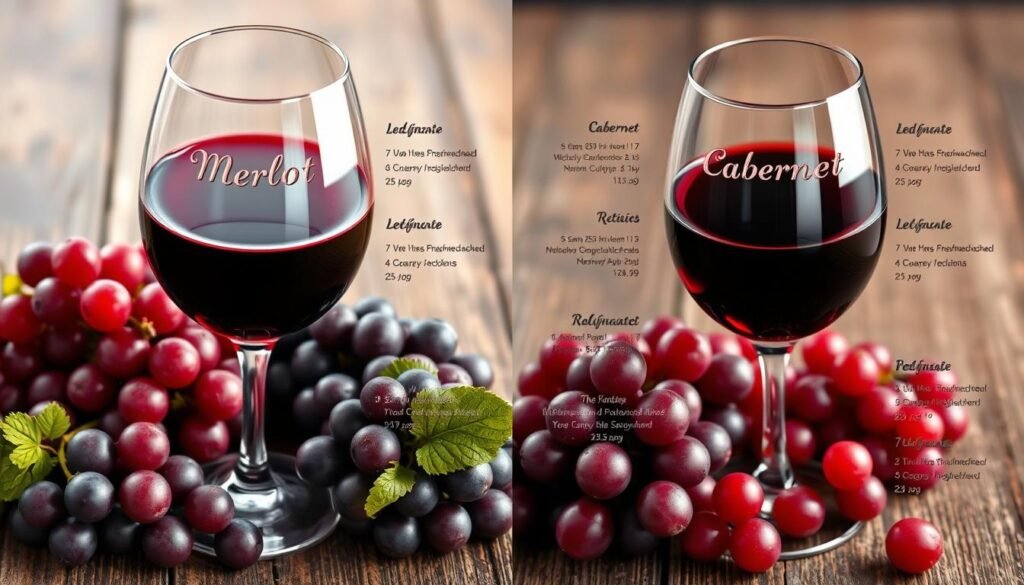
Texture and Body Comparison
Merlot and cabernet sauvignon feel different in your mouth. Merlot is smooth and medium to full-bodied. Cabernet sauvignon is bold and full-bodied.
These differences make merlot and cabernet sauvignon interesting to compare. Each wine has its own unique qualities.
Price Points and Value Considerations
Exploring wine, especially merlot vs cabernet price, requires understanding cost factors. Merlot and Cabernet Sauvignon prices vary by region, quality, and brand. Merlot is often more affordable, priced between $10 and $50. Cabernet Sauvignon can cost between $20 and $100 or more.
To get the most value, consider these factors:
- Region: Wines from places like Chile can be a good deal.
- Quality: Look for wines with good acidity, tannins, and flavor.
- Brand: Research brands to find the best price for your budget.
Here’s a look at Merlot and Cabernet Sauvignon prices:
| Wine Variety | Price Range |
|---|---|
| Merlot | $10-$50 |
| Cabernet Sauvignon | $20-$100+ |
When looking at merlot vs cabernet price, remember price is just one thing. Quality, region, and brand also matter. By researching and considering these, you can find a wine that’s both affordable and enjoyable.
Food Pairing Guidelines
Understanding the unique traits of each wine is key in merlot vs cabernet food pairing. Merlot is soft and fruity, perfect for tomato pasta, roasted chicken, and grilled pork. Cabernet Sauvignon, with its bold taste and tannins, pairs well with red meat, game, and strong cheeses.
Both merlot and cabernet sauvignon are favorites among wine lovers. Yet, they suit different dishes. Merlot goes well with lighter meals, while Cabernet Sauvignon is better for heartier ones. Here are some pairing tips:
- Merlot: pairs well with tomato-based pasta, roasted chicken, and grilled pork
- Cabernet Sauvignon: pairs well with red meat, game, and robust cheeses
Choosing between merlot and cabernet sauvignon depends on your taste and the meal. Knowing each wine’s characteristics helps you pair them better. This way, you can enjoy a more balanced and satisfying meal.
| Wine | Pairing Suggestions |
|---|---|
| Merlot | Tomato-based pasta, roasted chicken, grilled pork |
| Cabernet Sauvignon | Red meat, game, robust cheeses |
Health Benefits and Considerations
When we talk about merlot vs cabernet health benefits, both wines offer good points. Drinking red wine, like merlot and cabernet, in moderation can help. It may lower the risk of heart disease and some cancers.
Antioxidants play a big role in wine’s health benefits. Red wines, especially, have more antioxidants than white wines. Merlot vs cabernet benefits come from their high levels of procyanidin and resveratrol.
Antioxidant Content Comparison
The table below shows the antioxidant levels in merlot and cabernet sauvignon:
| Wine Type | Antioxidant Content |
|---|---|
| Merlot | High levels of procyanidin |
| Cabernet Sauvignon | High levels of resveratrol |
Both merlot and cabernet sauvignon are good for heart health. But, remember to drink wine in moderation. Too much can harm your health.
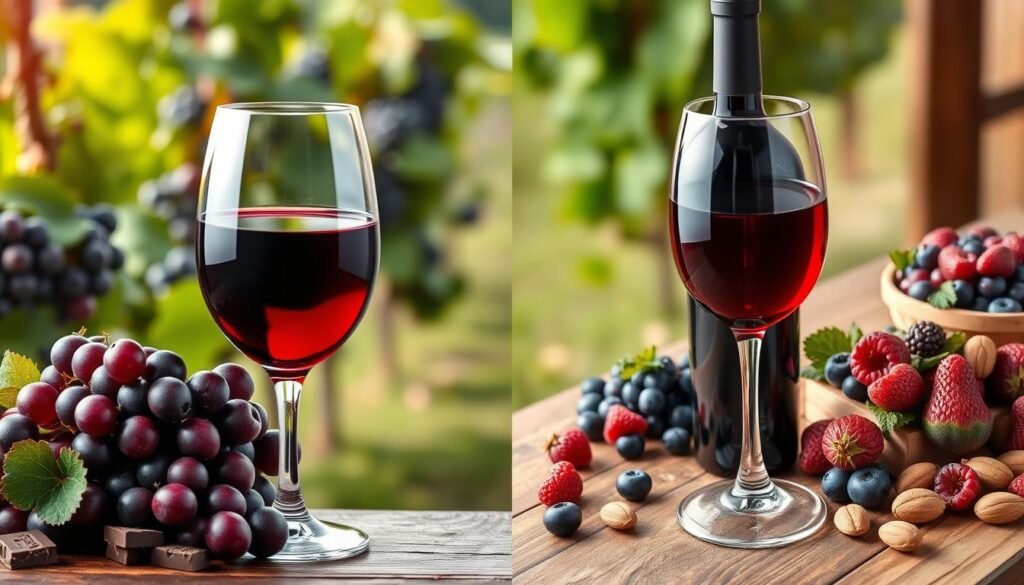
Serving and Storage Recommendations
When serving merlot vs cabernet, temperature is key. Merlot is best at 60-65°F, while cabernet sauvignon shines at 65-70°F. This is because merlot is medium-bodied, and cabernet is full-bodied.
For storing wine, a steady temperature is crucial. The best storage for red wine is between 58 – 65 degrees Fahrenheit. You can use a wine preservation system to keep opened wine fresh for up to 30 days. Here are some serving temperature guidelines:
- Light Bodied Red Wine: 37 – 59°F
- Medium-bodied Red Wine: 57 – 63°F
- Full-Bodied Red Wine: 63 – 66°F
Avoiding quick temperature changes is also important. A dual temperature zone wine dispenser helps store red and white wines at their best temperatures. By following these merlot vs cabernet serving tips, you can enjoy the unique flavors of each wine.
The secret to serving and storing wine is a consistent temperature. Avoid sudden changes. With the right conditions, you can fully enjoy your merlot and cabernet sauvignon.
Popular Regions and Producers
Different parts of the world have their own favorite wines. Merlot and Cabernet Sauvignon are grown in places like Bordeaux, Tuscany, and Napa Valley. The climate and soil decide which wine is made, with cooler areas making wines with more structure and tannins.
Some top wine makers include Chateau Petrus, Chateau Lafite, and Opus One. They make excellent wines, often aged in oak barrels. This aging process can last longer for Cabernet Sauvignon than Merlot, depending on the region and producer.
Here are some popular regions for Merlot and Cabernet Sauvignon:
- Bordeaux, France: Known for its Merlot and Cabernet Sauvignon blends
- Napa Valley, California: Recognized for its Cabernet Sauvignon and Merlot wines
- Tuscany, Italy: Produces high-quality Merlot and Cabernet Sauvignon wines
Wine choice can also depend on what you’re eating. Cabernet Sauvignon goes well with strong dishes like steak. Merlot is better with lighter foods like pizza. Knowing the different regions and producers helps you pick the right wine for your meal.
| Region | Merlot | Cabernet Sauvignon |
|---|---|---|
| Bordeaux | Popular | Flagship grape |
| Napa Valley | Recognized | Most planted red grape |
| Tuscany | High-quality | Produced in smaller quantities |
Conclusion
Exploring wine means knowing the differences between merlot and cabernet. Both have unique tastes and pairings. This knowledge makes enjoying wine even better.
Merlot is known for its fruity and smooth taste. Cabernet sauvignon, on the other hand, has bold and complex flavors. Your choice between merlot and cabernet depends on what you like.
Whether you love merlot’s easy taste or cabernet’s rich flavor, knowing the difference is key. This knowledge lets you try new wines and find your favorites. The adventure of trying different wines is just as exciting as the journey itself.

